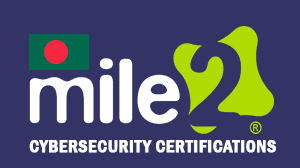Certified Incident Handling Engineer – C)IHE
Master cyber incident response with the Certified Incident Handling Engineer (C)IHE course. Learn how to detect, analyze, and mitigate cybersecurity threats using SIEM tools, forensic techniques, and real-world case studies. Enroll now to enhance your cybersecurity career!
Overview
The Certified Incident Handling Engineer (C)IHE course is designed to equip cybersecurity professionals with the expertise to effectively detect, analyze, respond to, and mitigate cyber threats. This comprehensive training program covers the incident response lifecycle, forensic investigation techniques, malware analysis, and the use of Security Information and Event Management (SIEM) tools. The course provides hands-on training to ensure participants gain real-world skills in managing and responding to security incidents.
Mile 2 C)IHE strictly follows NIST’s 800-61 to identify the four phases of incident response: (1) preparation for a cybersecurity incident, (2) detection and analysis of a security incident, (3) containment, eradication, and recovery, and (4) post-incident analysis. With C)IHE’s in-depth certification training, the student will learn to develop start-to-finish processes for establishing an incident-handling team, strategizing for potential attack types, recovering from attacks, and much more.
Exam Information
The Certified Incident Handling exam is taken online through Mile2’s Learning Management System and is accessible on you Mile2.com account. The exam will take approximately 2 hours and consist of 100 multiple choice questions.
A minimum grade of 70% is required for certification.
LEARNING OUTCOMES
By the end of this course, participants will be able to:
✅ Understand the principles of incident handling and response
✅ Analyze and mitigate cybersecurity threats and vulnerabilities
✅ Conduct forensic investigations and collect digital evidence
✅ Utilize SIEM tools to detect and analyze security incidents
✅ Perform malware analysis to identify and respond to threats
✅ Develop and implement incident response plans
✅ Apply industry best practices for security operations and risk management
Class Formats Available:
- Instructor Led
- Self-Study
- Live Virtual Training
Detailed Outline
Module 00: Course Introduction
Module 01: Incident Handling Explained
- Section 1: Introduction
- Section 2: What is an Incident?
- Section 3: What is Incident Handling?
- Section 4: Difference Between IH and IR
- Section 5: The Incident Response Process
- Section 6: Seven Reasons You Must Put Together an Incident Response Plan
- Section 7: How to Build an Effective Incident Response Team
- Section 8: Considerations for Creating an Incident Response Team
- Section 9: Tips for Incident Response Team Members
Module 02: Incident Response Policy, Plan and Procedure Creation
- Section 1: Introduction
- Section 2: Incident Response Policy
- Section 3: Incident Response Plan
- Section 4: Incident Response Procedures
- Section 5: Sharing Information with Outside Parties
Module 03: Incident Response Team Structure
- Section 1: Introduction
- Section 2: Team Models
- Section 3: Team Model Selection
- Section 4: Incident Response Personnel
- Section 5: Dependencies within Organizations
Module 04: Incident Response Team Services
- Section 1: Introduction
- Section 2: Intrusion Detection
- Section 3: Advisory Distribution
- Section 4: Education and Awareness
- Section 5: Information Sharing
Module 05: Incident Response Recommendations
- Section 1: Introduction
- Section 2: Establish a formal Incident Response Capability
- Section 3: Establish Information Sharing Capabilities
- Section 4: Building an Incident Response Team
Chapter 06: Preparation
- Section 1: Introduction
- Section 2: Threat Hunting
- Section 3: Threat Analysis Frameworks
- Section 4: Tools and Toolkits
- Section 5: Policy
- Section 6: Procedures
- Section 7: Preventing Incidents
Module 07: Detection and Analysis
- Section 1: Attack Vectors
- Section 2: Signs of an Incident
- Section 3: Sources of Precursors and Indicators
- Section 4: Incident Analysis
- Section 5: Incident Documentation
- Section 6: Incident Prioritization
- Section 7: Incident Notification
Module 08: Containment, Eradication and Recovery
- Section 1: Selecting the Right Containment Strategy
- Section 2: Gathering and Handling Evidence
- Section 3: Identifying the Attacking Hosts
- Section 4: Eradication and Recovery
Module 09: Post Incident Activity
- Section 1: Introduction
- Section 2: Lessons Learned
- Section 3: Using Collected Incident Data
- Section 4: Evidence Retention
Module 10: Incident Handling Checklist
- Section 1: Introduction
- Section 2: Building Checklists
Module 11: Incident Handling Recommendations
- Section 1: Introduction
- Section 2: Recommendations
- Section 3: Implement Threat Intel
Module 12: Coordination and Information Sharing
- Section 1: Introduction
- Section 2: Coordination
- Section 3: Purple Teaming
- Section 4: Information Sharing Techniques
- Section 5: Granular Information Sharing
- Section 6: Sharing Recommendations
Lab Detailed
- Lab 01: Identifying Incident Triggers
- Lab 02: Drafting Incident Response Procedures
- Lab 03: Identifying and Planning for Your Dependencies
- Lab 04: Testing Your Plan and Using a Feedback Loop to Future Proof Your Response
- Lab 05: Drafting General Security Policies
- Lab 06: Leveraging SIEM for Advanced Analytics
- Lab 07: Use Velociraptor and Gather Evidence
- Lab 08: Creating Request Tracker Workflow
- Lab 09: Lessons Learned and Documentation
- Lab 10: Creating and Incident Handling Checklist
- Lab 11: Drafting Incident Response Recommendations for Improvements
- Lab 12: Sharing Agreements and Reporting Requirements
Requirements
- 12 months network technologies
- Basic knowledge of network security and cybersecurity principles
- Familiarity with operating systems, firewalls, and security tools
- Experience with incident response processes (recommended but not required)
Features
- Hands-on training with real-world cyber incident scenarios
- Comprehensive coverage of incident handling, forensic investigation, and malware analysis
- SIEM and SOC operations training for effective threat monitoring
- Interactive labs and case studies to build practical skills
- Globally recognized certification for career advancement
- Expert instructors with industry experience
Target audiences
- Incident Responders & SOC Analysts
- Cybersecurity Engineers & IT Security Professionals
- Network Administrators & System Administrators
- Penetration Testers & Ethical Hackers
- Digital Forensics Experts
- Government & Military Cybersecurity Personnel

